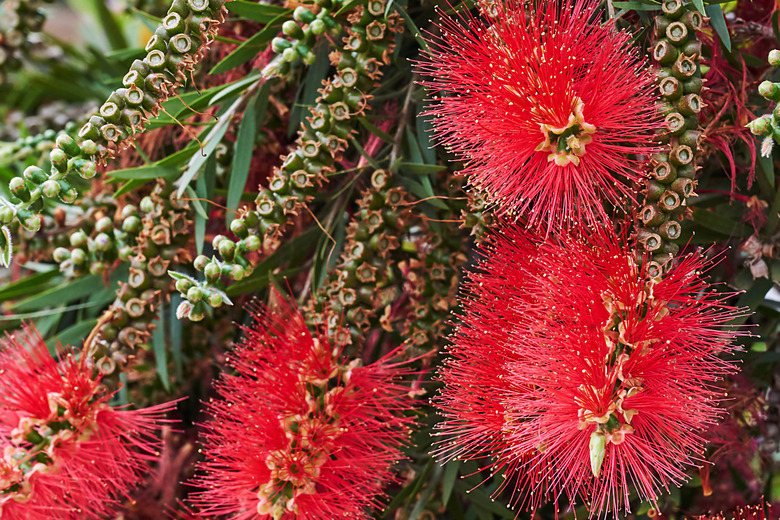Life Cycle Of The Bottle Brush Plant
Boasting bold red spikes in the summer and fall, the crimson bottle brush plant (Callistemon citrinus) is perhaps the most well-known bottle brush plant species. There are many other popular cultivars, however, and all are evergreen shrubs and trees capable of putting on quite a show in U.S. Department of Agriculture plant hardiness zones 9 and 10.
An Australia native, the bottle brush prefers warm weather and moist but well-draining soil. If you provide lots of sun and a little fertilizer, your bottle brush plant will reward you by adding lots of color and texture to the landscape around your home. It will also attract birds and nectar-feeding insects like butterflies. Plant with caution, however, if you have tree pollen allergies as the bottle brush may irritate them.
Growing Conditions
Growing Conditions
Bottle brush trees do best on soil that drains well. They can tolerate a moderate amount of salt in the soil, but too much salt will damage or kill the roots. Young plants require frequent watering but established individuals become quite drought tolerant. Thought it prefers warm climates, most bottle brushes will tolerate an occasional frost or cold snap of temperatures below freezing. If your area experiences cold temperatures often, consider planting the hardier lemon bottle brush (Callistemon pallidus), which is hardy to USDA zone 7. Make sure you place the bottle brush in full sun so it will produce healthy flowers.
Bottle Brush Tree Growth Rate
Bottle Brush Tree Growth Rate
Your bottle brush tree will grow fairly slowly but you should still choose a planting location that provides ample headroom. Most selections reach between 6 and 15 feet tall, but small cultivars such as the dwarf bottle brush (Callistemon citrinus 'Little John,' zones 8-10) will reach only a petite 3 feet in height, placing it in the shrub category. The growth of the tree or shrub depends on the amount of sunlight it receives, the climate, the water and even the soil. Although the plants can sometimes grow slowly, they're worth the wait, producing showy flowers reliably throughout their 20- to 40-year lifespan.
Care and Maintenance
Care and Maintenance
Water your bottle brush plant frequently after you plant it. After that, keep the soil around the plant moist but never wet or soggy. Withhold supplemental water during the winter months, allowing the plant to rely on natural rainfall. This allows the plant to enter a resting phase. Resume watering in the spring. Fertilize the plant with a slow-release 8-8-8 fertilizer once in the spring and again in the summer. To encourage more blossoms, snip spent flowers at their base.
Pruning also encourages flowering since the plant will then put more energy into flowering than it does growing new branches. Lightly prune the new growth rather than the older existing wood near the center of the tree. If the plant fails to flower after a spring pruning, don't worry. Simply remove less of the new growth when pruning next year.
Flowers and Seeds
Flowers and Seeds
The bottle brush gets its name from the shape of its spiked flowers. Each bottle brush-shaped bloom is composed of many separate flowers. The pollen sits on the end of the long filaments and you'll find the seeds contained inside a small fruit that forms on the stem. The bottle brush is unusual because the fruits tend to stay on the tree for one or more years before they release their seeds. In nature, the fruits sometimes open and release their seeds during brush fires.
Propagation
Propagation
You can grow new bottle brush plants from seeds or cuttings. If you want to grow the bottle brush from seed, collect the closed fruits and put them into a paper bag. When the fruits open and the seeds spill out, sow them into well-draining soil in the spring. To propagate the plant from cuttings, choose plant stems that are healthy and somewhat mature, but avoid choosing both the oldest and the youngest stems. Cut each stem at its base and then place it in a moist rooting medium. You may also place stems in a bucket of water where they may form roots on their own. When it has, plant the stem in a sunny location with good soil. if desired, you can plant the stem or seeds in a container and transfer your plants to the garden once they've established themselves.
